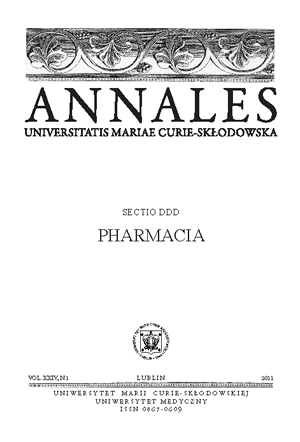Nefrotoksyczność cyklosporyny A: Rola stresu oksydacyjnego
Słowa kluczowe:
Cyklosporyna A, nefrotoksyczność, stres oksydacyjny, mitochondriaAbstrakt
Cyklosporyna A jest inhibitorem kalcyneuryny, jednym z podstawowych leków stosowanych w terapii immunosupresyjnej po przeszczepie narządów czy szeregu chorób immunologicznych. Głównym efektem ubocznym jej stosowania jest nefrotoksyczność. W patogenezie uszkodzenia nerki przez CsA bierze udział wiele mechanizmów. Do mediatorów zaburzeń funkcji nerek i uszkodzeń morfologicznych należą min. układ renira-angiotensyna-aldosteron, produkcja wewnątrznerkowych eikozanoidów, czy endotelina. Istotne znaczenie w uszkodzeniu narządu przez cyklosporynę przypisuje się mechanizmom stresu oksydacyjnego i uwalnianym w nadmiarze wolnym rodnikom tlenowym. Procesy te zachodzą w komórkach nabłonkowych kanalików nerkowych, w komórkach śródbłonka naczyń czy w komórkach kłębuszków nerkowych. Biorą udział w zaburzeniach funkcji nerek oraz w powstawaniu uszkodzeń morfologicznych takich jak zmiany naczyniowe doprowadzające do zmian niedokrwiennych, włóknienie śródmiąższowe, postępujące twardnienie kłębuszków czy zanik kanalików i apoptoza komórek nabłonkowych.
Bibliografia
1. Akool E.S. at al.: Molecular mechanisms of TGF beta receptor-triggered signaling cascades rapidly induced by the calcineurin inhibitors cyclosporin A and FK5061. J. Immunol., 181, 2831, 2008.
2. Amore A., Emancipator S.N., Cirina P.: Nitric Oxide mediates cyclosporine-induced apoptosis in cultured renal cells. Kidney Int., 57, 1549, 2000.
3. Amudha G., Josephine A., Varalakshmi P.: Role of lipoic acid in reducing the oxidative stress induced by cyclosporine A. Clin. Chim. Acta, 372, 134, 2006.
4. Anjaneyulu M., Tirkey N., Chopra K.: Attenuation of cyclosporine-induced renal dysfunction by catechin: possible antioxidant mechanism. Renal Fail., 25, 691, 2003.
5. Atessahin A., Ceribasi A.O., Yilmaz S.: Lycopene, a carotenoid, attenuates cyclosporine-induced renal dysfunction and oxidative stress in rats. Basic Clin. Pharmacol. Toxicol., 100, 372, 2007.
6. Burdmann E.A. et al.: Cyclosporine nephrotoxicity. Semin. Nephrol. 23, 465, 2003
7. Capasso G. et al: In vivo effect of the natural antioxidant hydroxytyrosol on cyclosporine nephrotoxicity in rats. Nephrol. Dial. Transplant., 23, 1186, 2008.
8. Damzy D. et al: Role of endothelin-1 and Nitric Oxide bioavailability in transplant-related vascular injury: comparative effects of rapamycin and cyclosporine. Circulation, 114, 214, 2006.
9. DeHornedo J.P. et al: Cyclosporin A causes oxidative stress and mitochondrial dysfunction in tubular renal cells. Nefrologia, 27, 565, 2007.
10. Hagar H.H., El Etter E., Arafa M.: Taurine attenuates hypertension and renal dysfunction induced by cyclosporine in rats. Clin. Exp. Pharmacol. Physiol., 33, 189, 2006.
11. Hakan A. et al.: Effect of Hyperbaric oxygen on cyclosporine-induced nephrotoxicity and oxidative stress in rats. Renal Failure, 29, 495, 2007.
12. Iglesias-deLaCruz M.C. et al.: Hydrogen peroxide increases extracellular matrix mRNA through TGF-β in human mesangial cells. Kidney Int., 59, 87, 2001.
13. Inselmann G., Hannemann J., Baumann K.: Cyclosporine A induced lipid peroxidation and influence on glucose-6-phosphatase in rat hepatic and renal microsomes. Res. Commun. Chem. Pathol. Pharmacol., 68, 189, 1990.
14. Jennings P. et al.: Cyclosporine A induces senescence in renal tubular epithelial cells. Am. J. Physiol. Renal Physiol., 293, 831, 2007.
15. Jeon S.H. et al.: Prednisolone supresses cyclosporine A – induced apoptosis but not cell cycle arrest in MDCK cells. Arch. Biochem. Biophys., 435, 382, 2005.
16. Josephine A. et al.: Oxidative and nitrosative stress mediated renal cellular damage induced by Cyclosporine A: Role of Sulphated Polysaccharides. Biol. Pharm. Bull., 30,1254, 2007.
17. Kim J.S., He L., Lemasters J.J.: Mitochondrial permeability transition: a common pathway to necrosis and apoptosis. Biochem. Biophys. Res. Commun., 304, 463, 2003.
18. Kowaltowski A.J., Castilho R.F., Vercesi A.E.: Mitochondrial permeability transition and oxidative stress. FEBS lett., 495, 12, 2001.
19. L’Alzou B et al.: In vitro models to study mechanisms involved in cyclosporine A-mediated glomerular contraction. Arch. Toxicol., 73, 337, 1999.
20. Navarro-Antolin J. et al.: Role of peroxynitrite in endothelial damage mediated by cyclosporine A. Free Radical Biol. Med., 42, 394, 2007.
21. Nishida M et al.: Role of hydrogen peroxide in cyclosporine-induced renal tubular cell (LLC-PK1) injury. J. Pharmacol. Sci., 91, 255, 2003
22. Parra Cid T. et all.: Antioxidant nutrients protect against cyclosporine A nephrotoxicity. Toxicology, 189, 99, 2003.
23. Raymond M.A. et al.: Blockade of the apoptotic machinery by cyclosporin A redirects cell death toward necrosis in arterial endothelial cells: regulation by reactive oxygen species and cathepsin D. Faseb J., 17, 515, 2003.
24. Rezzani R., Rodella L., Buffoli B.: Change in renal heme oxygenase expression in cyclosporine A-induced injury. J. Histochem. Cytochem., 53, 105, 2005.
25. Sonaje K. et al.: Development of biodegradable nanoparticles for oral delivery of Ellagic Acid and eveluation of their antioxidant efficacy against cyclosporine A- induced nephrotoxicity in rats. Pharmaceutical Research, 24, 899, 2007.
26. Tariq M. et al.: N- Acetylcysteine attenuates cyclosporin-induced nephrotoxicity in rats. Nephrol. Dial. Transplant., 14, 923, 1999.
27. Uz E. et al.: Nigella sativa oil for prevention of chronic cycloxporine nephrotoxicity: an experimental model. Am. J. Nephrol., 28, 517, 2008.
28. Wongmekiat O., Leelarugrayub N., Thamprasert K.: Beneficial effect of shallot (Allium Ascalonicum L.) extract on cyclosporine nephrotoxicity in rats. Food and Chemical Toxicol., 46, 1844, 2008.
29. Vetter M. et al.: Cyclosporin A disrupts bradykinin signaling through superoxide. Hypertension, 41, 1136, 2003.
30. Zhong Z. et al.: Cyclosporin A causes a hypermetabolic state and hypoxia in the liver: prevention by dietary glycine. J. Pharmacol. Exp. Therapeutics, 299, 858, 2001.
Pobrania
Opublikowane
Numer
Dział
Licencja
Prawa autorskie (c) 2011 Autorzy

Praca jest udostępniana na licencji Creative Commons Attribution-NonCommercial-NoDerivatives 3.0 Unported License.


